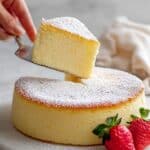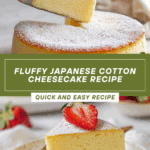Japanese Cotton Cheesecake Recipe
Japanese Cotton Cheesecake is a soft, fluffy, and light Japanese-style cheesecake that melts in your mouth. It combines the richness of cream cheese with an airy meringue to create a delicate texture and subtle sweetness. This recipe uses a water bath baking method to ensure a creamy center and tender crumb perfect for an elegant dessert or afternoon treat.
- Prep Time: 20 minutes
- Cook Time: 1 hour 15 minutes
- Total Time: 1 hour 35 minutes
- Yield: 6 servings 1x
- Category: Dessert
- Method: Baking
- Cuisine: Japanese
- Diet: Vegetarian
Ingredients
Scale
Dry Ingredients
- 1/4 cup (30 g) cake flour
- 2 tablespoon (20 g) cornstarch
- 1/3 cup (70 g) granulated sugar
Dairy & Eggs
- 3/4 cup (180 g) cream cheese (full fat brick)
- 2 tablespoon (30 g) unsalted butter (room temperature)
- 3 1/2 tablespoon (50 g) milk (full fat)
- 3 large egg yolks (room temperature)
- 3 large egg whites (room temperature)
Flavorings
- 1/2 teaspoon (2 g) vanilla extract
- 1/2 teaspoon (2 g) lemon juice
- Powdered sugar (for garnish)
Instructions
- Preheat and prepare pan: Preheat your oven to 300°F (150°C). Line the bottom and sides of a 6-inch round baking pan with parchment paper to prevent sticking and facilitate easy removal of the cake.
- Melt the butter and cream cheese: Set up a double boiler by boiling water in a small saucepan. Place the cream cheese, unsalted butter, and milk in a heatproof bowl over the simmering water. Whisk continuously until the butter and cream cheese are fully melted and combined, reaching approximately 130°F (55°C).
- Add egg yolks and vanilla: Remove the bowl from the heat. Whisk in the egg yolks and vanilla extract thoroughly until the mixture is smooth and homogenous.
- Sift in the dry ingredients: Using a fine mesh sieve, sift the cake flour and cornstarch into the wet ingredients. Whisk until the batter is smooth, then strain through the sieve again to eliminate any lumps for an ultra-smooth texture.
- Make the meringue: In a large clean mixing bowl, combine the egg whites and lemon juice. Using an electric hand mixer, whip the egg whites on high speed until frothy. Gradually add the granulated sugar in three batches while continuing to beat, until the meringue forms medium soft peaks—peaks that fold over slowly like soft serve ice cream. Then beat on low for 30 seconds to remove large air bubbles.
- Fold one-third of meringue into batter: Add one-third of the meringue to the egg yolk batter and gently fold until smooth and fully incorporated, lightening the batter.
- Fold batter into remaining meringue: Pour the batter back into the remaining two-thirds of meringue and fold gently using a rubber spatula to combine. Take care not to overmix to preserve the airy texture.
- Prepare the pan and pour batter: Pour the batter into the prepared lined baking pan. To release large air bubbles, drop the pan from about 5 inches onto the countertop gently. Place this pan inside a larger deep baking tray and pour in 1 to 2 cm of boiling water to create a water bath for gentle, even baking.
- Bake the cheesecake: Bake at 300°F (150°C) for 30 minutes. Then reduce the heat to 230°F (110°C) and bake for an additional 30 minutes. Finally, increase the oven temperature to 275°F (135°C) and bake for 13-15 more minutes. Watch carefully to prevent cracking; if cracks appear, slightly open the oven door for 5 seconds to release steam. The cheesecake is done when the top is golden and a toothpick inserted into the center comes out mostly clean.
- Cool the cheesecake: Turn off the oven and leave the cheesecake inside with the door slightly ajar for 15 minutes. Remove the water bath and keep the cake in the oven for another 15 minutes to avoid temperature shock and shrinking. Remove from the pan and place on a cooling rack until completely cooled. Dust with powdered sugar before serving for an elegant finish.
Notes
- Use full-fat cream cheese and milk for the best creamy texture.
- Ensure eggs are at room temperature to achieve optimal meringue volume.
- Folding the meringue gently helps maintain airiness essential for the cotton-like texture.
- Water bath baking (bain-marie) prevents the cake from drying out and cracking by providing gentle, even heat.
- Cooling the cake gradually in the oven reduces shrinkage and helps maintain its delicate structure.
- Check the oven temperature accuracy, as this cake is sensitive to overheating which leads to cracks.
- Serve chilled or at room temperature, the cake improves in texture after refrigeration.
Keywords: Japanese cheesecake, cotton cheesecake, fluffy cheesecake, baked cheesecake, Japanese dessert, soufflé cheesecake, soft cheesecake
Find it online: https://foodbylina.com/japanese-cotton-cheesecake-recipe/

